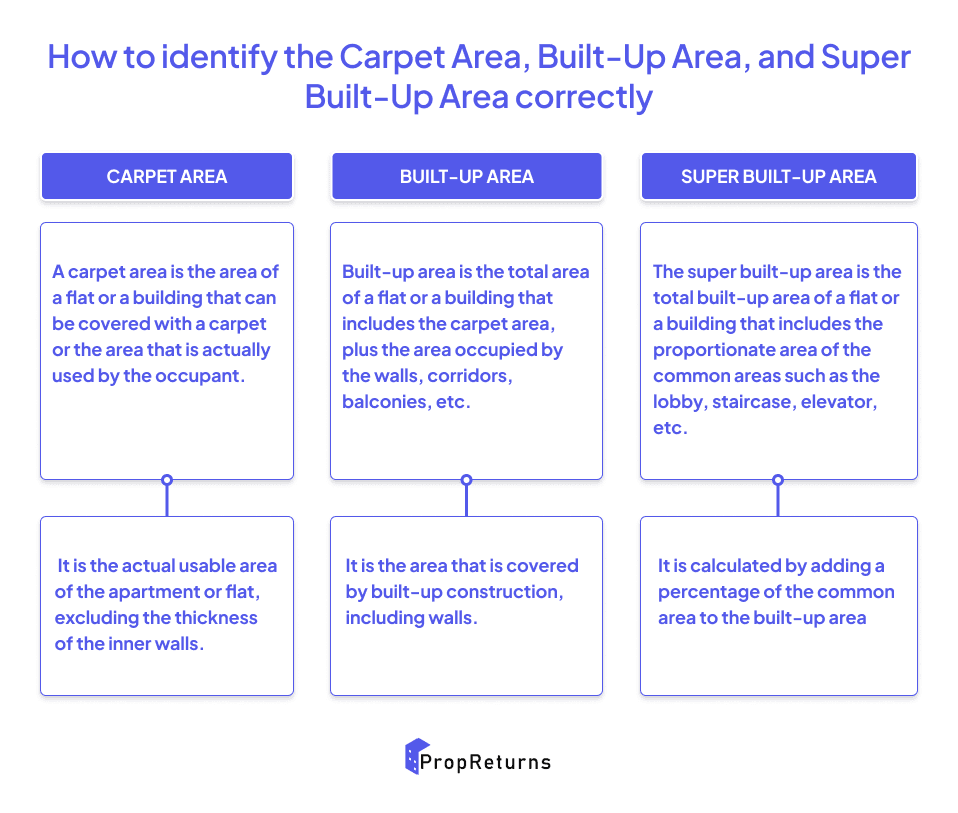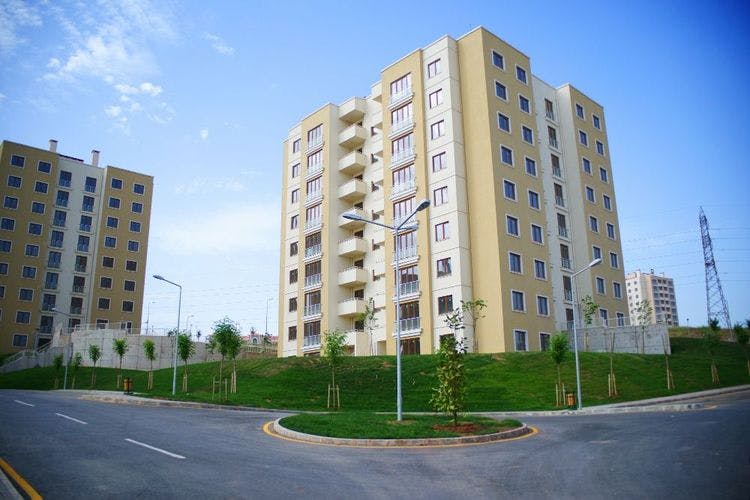Imagine you are in the market for a new apartment, and you have found the perfect one listed online. The pictures look fantastic, and the price seems reasonable. You visit the property, and it looks even better in person. The real estate agent shows you around and mentions that the carpet area is 1,000 square feet.
You are impressed and ready to make an offer until the agent informs you that the built-up area is 1,200 square feet, and the super built-up area is 1,500 square feet. You are now confused and wondering what the difference is between these terms.
Real estate terminologies can be confusing, and one common source of confusion is understanding the differences between built-up areas, carpet areas, and super built-up areas. These terms are often used interchangeably, but they have distinct meanings and implications when it comes to property measurements and pricing.
In this article, we will delve into the definitions and differences between these terms, shedding light on their significance in the real estate industry.
What is the Carpet Area?
Carpet area means the actual usable area of an apartment, excluding the thickness of the walls. It is the area that can be covered by a carpet or the actual floor area of the apartment.
The carpet area does not include common areas, such as the lift lobby, staircase, or passages. It The carpet area is the most important aspect of a property as it defines the usable area of an apartment.
What is RERA Carpet Area?
RERA (Real Estate (Regulation and Development) Act) defines the term "Carpet Area" as the net usable floor area of an apartment, excluding the area covered by the external walls, areas under service shafts, exclusive balcony or verandah areas, and exclusive open terrace area, but includes the area covered by the internal partition walls of the apartment.
Typically, RERA carpet area is about 5% more than the regular carpet area. For instance, if the carpet area of a house is 1,000 square feet, RERA carpet area will be around 1,050 square feet.
If you want to find a RERA property, you can use our RERA finder.
How to calculate Carpet Area and RERA Carpet Area?
Calculating the carpet area and RERA carpet area involves understanding the specific guidelines and definitions provided by the Real Estate Regulatory Authority (RERA)
Here is the formula to calculate Carpet Area.
Formula:
Carpet area = Area of bedroom + living room + toilets -- the thickness of the inner walls.
RERA Carpet area = Area of bedroom + living room + toilets + the thickness of the inner walls.
What is a Built-up Area?
Built-up Area means the total area of an apartment or building, including the carpet area, as well as the area covered by the external walls, common areas, and amenities. It is the sum total of the carpet area and the proportionate share of the common areas, such as lobbies, corridors, lifts, staircases, and other shared facilities that are allocated to each apartment.
How to Calculate Built-up Area?
Here is the formula to calculate built-up area.
Formula:
Built-up Area = Carpet Area + Thickness of Walls + Other areas (such as the kitchen, bathrooms, etc.) + Common Spaces
Carpet Area Vs Built Up Area
The difference between carpet area and built-up area is that the built-up area includes the thickness of the walls, balconies, and other areas not included in the carpet area. Therefore, the built-up area is always higher than the carpet area.
What is a Super Built-up Area?
The super built-up area means the combination of the total built-up area and additionally a proportionate amount of the common spaces such as the lift lobby, staircase, and passages. It also includes areas of amenities such as clubhouses, swimming pools, and gardens. A super-built-up area is also known as a saleable area, as it was the area previously used to calculate the price of the property.
How to calculate Super Built-up Area?
To calculate the super built-up area, a builder or developer will take the total built-up area of the apartment and add a percentage of the common areas such as the lift lobby, staircase, and passages. The percentage added varies from project to project and can range from 25% to 50%.
Formula:
Super Built-up Area = Built-up area + proportionate common area
What is The Loading Factor?
The loading factor refers to the percentage of the additional or built-up area added to the carpet area of a property. The loading factor is typically expressed as a percentage and varies from one property to another, depending on factors such as the type of property, location, and developer's design. It is also regulated by local building codes, development regulations, and real estate norms in different regions or countries.
Built-Up Area Vs Super Built-up Area:
The difference between built-up area and super built-up area is that built-up area includes the carpet area and the thickness of walls, balconies, and other areas not included in the carpet area, while super built-up area includes the built-up area and a proportionate share of the common spaces such as the lift lobby, staircase, and passages.
Carpet Area, Built-Up Area, Super Built-Up Area: Area-Wise Inclusion List
| Carpet Area | Built-up Area | Super built-up Area | |
|---|---|---|---|
| Bedroom | Yes | Yes | Yes |
| Dining room | Yes | Yes | Yes |
| Bathroom | Yes | Yes | Yes |
| Study room | Yes | Yes | Yes |
| Utility areas | No | Yes | Yes |
| Pooja room | Yes | Yes | Yes |
| Balcony | No | Yes | Yes |
| Staircase (inside the house) | Yes | Yes | Yes |
| Staircase (outside the house) | No | Yes | Yes |
| Terrace | No | Yes | Yes |
| Verandah | No | Yes | Yes |
| Lift | No | No | Yes |
| Lobby | No | No | Yes |
| Garden | No | No | Yes |
| Swimming pool | No | No | Yes |
How to identify the Carpet Area, Built-Up Area, and Super Built-Up Area correctly
Carpet area, built-up area, and super built-up area are terms commonly used in real estate to describe the different areas of a property. The main difference between these terms is as follows:

Carpet Area: A carpet area is the area of a flat or a building that can be covered with a carpet or the area that is actually used by the occupant. It is the actual usable area of the apartment or flat, excluding the thickness of the inner walls.
Built-up Area: Built-up area is the total area of a flat or a building that includes the carpet area, plus the area occupied by the walls, corridors, balconies, etc. It is the area that is covered by built-up construction, including walls.
Super Built-up Area: The super built-up area is the total built-up area of a flat or a building that includes the proportionate area of the common areas such as the lobby, staircase, elevator, etc. It is calculated by adding a percentage of the common area to the built-up area.
In summary, the carpet area is the actual usable area, the built-up area is the total area covered by the built-up construction, and the super built-up area includes common areas in addition to the built-up area. It is important to clarify which area is being referred to when discussing a property to avoid any confusion.
Stamp Duty and Registration
The Real Estate (Regulation and Development) Act, made in 2016 (RERA) has a substantial influence on the real estate sector in India. One of the key changes brought about by RERA is the mandate to sell properties based on the carpet area, which is the actual usable area within the walls of a property.
Previously, properties were sold based on the super built-up area, which included common spaces such as staircases, corridors, and elevators, in addition to the actual usable area. This often resulted in confusion and disputes between buyers and developers regarding the actual size of the property and the corresponding price.
With the mandate to sell properties based on the carpet area, many authorities have also started registering properties using carpet areas as a reference. This has led to a reduction in stamp duty and other charges as they are now calculated based on the actual usable area of the property. This has resulted in payment savings for homebuyers who earlier spent a higher duty when registering a property founded in the super built-up area.
Use our calculator to find the stamp duty on our property.
Common Mistakes that Property Buyers make
When purchasing a new home, it's important to be aware of the terminology used in the real estate industry and to understand the concept of carpet area. One common mistake that homebuyers make is assuming that the carpet area includes all areas of the apartment, including balconies and terraces. However, these utility areas are typically not included in the carpet area calculation, which can result in a smaller usable space than expected.
To avoid this mistake, it's important to clarify with the builder or seller what is included in the carpet area calculation and what is not. Make sure to ask for a detailed floor plan that clearly indicates the carpet area and any excluded areas such as balconies or terraces. Additionally, it's advisable to physically inspect the property to get a better understanding of the layout and the usable space available.
By being aware of this common mistake and taking the necessary steps to avoid it, homebuyers can ensure that they make an informed decision and get the most value for their investment.
Conclusion
Being knowledgeable about the built-up area vs carpet area vs super built-up area helps individuals navigate the real estate market with confidence and make informed choices, ensuring that they get the right value for their investment or rental.
Buyers and renters must be aware of these distinctions to make informed decisions and ensure they are getting the space they need and paying for what they expect. It's important to carefully review the floor plans, agreements, and legal documents of a property to determine the exact area being offered and the associated costs.
If you are interested in investing in commercial real estate or selling your commercial real estate, PropReturns can help you do this easily, without any hassles.
